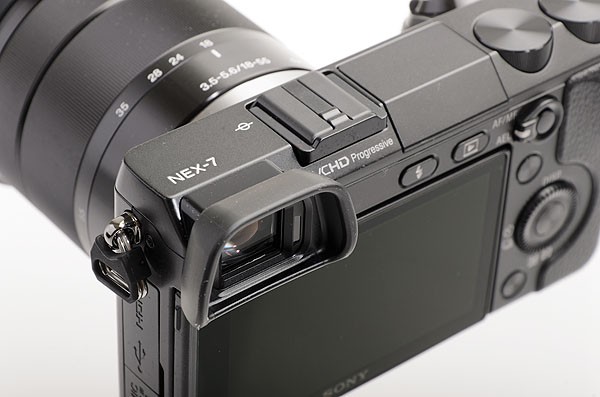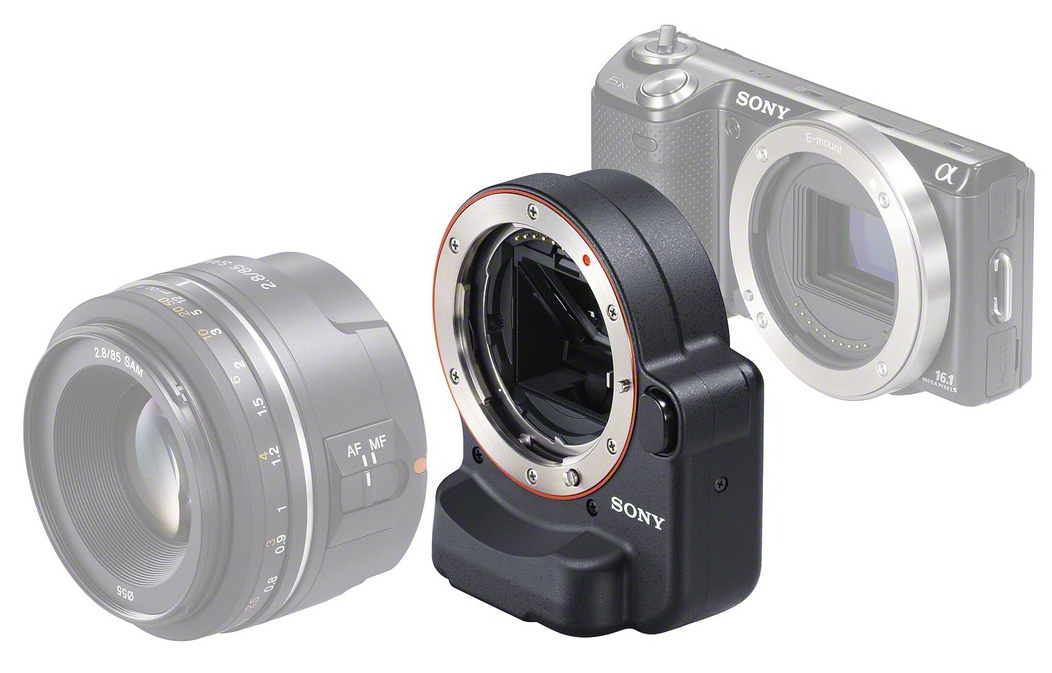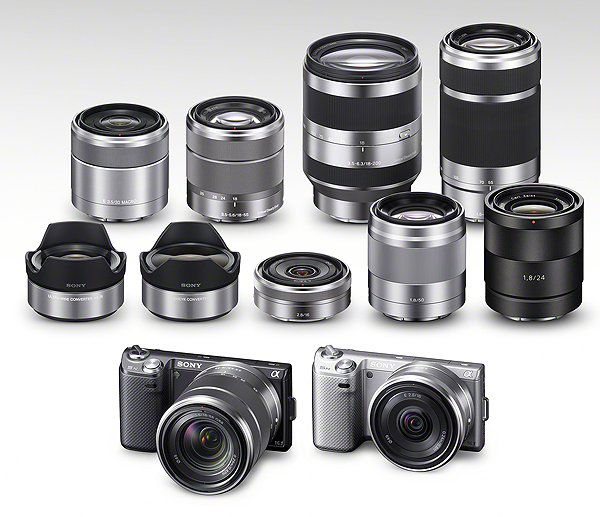The EVF future
At photokina 2010, Paul Genge from Sony pretty much told me that Sony’s future lay in the EVF (translucent mirror or otherwise, Electronic View Finder) models. He was not able to say anything firm. Since then, I’ve spoken to him on several occasions and he has repeated that Sony left all options open but the EVF design was likely to be the way ahead. What he has not said directly to me is that conventional SLR design – Optical View Finder – was off the roadmap.
EVF does away with the need for the finder to be positioned anywhere near the optical axis. Noses can safely hit thin air not a rear screen. Unless you are left eyed. NEX-7 with ocular surround fitted.
Although Sony did not attend Focus on Imaging 2012, the UK website TechRadar secured an interview statement during Focus week, in which Paul appears to have confirmed without ambiguity that the future was EVF-only, and that the forthcoming full frame successor to the Alpha 900 would be an SLT-EVF design. At the same time, we learn that the 70-200mm SSM G and 70–400mm SSM G lens are to be revised for 2013.
We know, from several sources, that Sony is not currently making all its lenses – even the high end ones – in one facility, or in its own workshops. I believe the 70-400mm SSM G is a contracted-out design and that the 70-300mm SSM G has always been made by a third party lensmaker. This is nothing new; the Minolta 100-400mm APO was patented by Tokina and sold to Minolta as an exclusive (no-one else got the lens) and the same company made some if not all the 100-300mm APO lenses. Using different sources means that various types of coating are appearing; traditional Minolta style – the multi achromatic coating, Carl Zeiss T*, Tamron’s BBAR-derived coatings, some Sony multicoatings of unknown pedigree on Chinese SAM lenses, and a new water and oil resistant coating due to be used for the revised 70-200mm and 70-400mm.
This coating is nearly always combined with weather or splash proof design, and companies which have the ability to apply it include Hoya (Tokina, Kenko, Marumi, Pentax), Olympus, Canon, Nikon, and Sigma. Sigma is very significant as they have installed new coating lines recently and they are going through a bit of a subcontracting boom. Their facilities are all in Japan, they are on high ground and were slightly affected by the earthquake but not by the tsunami. They have a long history of building lenses and cameras for Leica, Carl Zeiss, Panasonic, Olympus, Canon/Kodak and interchangeable lenses for nearly all the major names.
If the high end tele zooms are to be revised, weatherproofing and the new coating will certainly arrive along with a synchronisation of lens appearance and finish. But I’m willing to bet something else is involved. The SSM focus system is only partially suitable for contrast-detect operation. It works, on static subjects, but unless some major advance is made in CD-AF it’s lacking the refinement and speed of the AF found in SEL (native Sony NEX) lenses. I’ve tested the 70-400mm on the LA-EA1 with NEX-7, I can work with the lens comfortably on most subjects and the camera is very good at refusing to take the shot until focus is 100% locked.
All that just to get 2X the magnification – NEX-7 with LA-EA1 and 70-400mm SSM G (an operational kit, if not fast) compared to Tamron 18-200mm NEX lens with the correct type of contrast-detection friendly focus motor and protocols.
What Sony must surely want to do is dispose of the SLT (‘translucent’) pellicle mirror and the Phase Detection AF module. It makes most sense to focus, meter, view and expose from one single sensor. In order to do so, lens focus motors need a slightly different control protocol. SSM lenses are already CD-AF compatible, as are SAM onboard focus motor lenses, but they don’t match the NEX system SEL lenses. Sigma HSM and Tamron USD Alpha mount lenses are not CD-AF compatible and do not work correctly on the LA-EA1 adaptor. Upgrading matters most with tele lenses, and they are also most likely to be used in adverse weather for wildlife, news or sports. So my guess is that the upgrade to these lenses will be comprehensive and that it will look forward to possible Sony Alpha bodies with either no SLT mirror, or a movable SLT mirror and choice between PD-AF and CD-AF.
As for the EVF itself, it’s one stage away from being better than a very good optical finder on balance of qualities. Unlike optical finders, the EVF is not susceptible to user eyesight error (incorrect dioptre correction, combined with eye focusing accommodation) and presents the user with a low resolution but otherwise very accurate view of the image focused on the sensor. It can do this at light levels where optical finders become difficult to use, while also presenting a review of the captured image if desired – ‘shot success’ confirmation.
Differences between the ‘identical’ EVF of the NEX-5n accessory finder FDA-EV1S and the NEX-7 fixed built-in version are mostly down to the difference between the 16 megapixel generation 2 sensor, and the 24 megapixel. Response speed, low light noise, quality of colour and contrast are all influenced more by the two very different sensors. User observations that one is better or worse than the other will nearly always be down to this, and variations in settings between the two cameras compared.
There are things you can do on an EVF, such as magnifying a focus point well away from the centre, which simply can’t be done at all with an optical finder and may not always be convenient to do on a rear screen. The fact that EVFs permit eye-level video shooting, and that video is now a permanent feature of the Alpha class of camera from entry to semiprofessional, makes the EVF design change more inevitable.
Paul Genge had a short exchange of information with me when I was considering selling my Alpha 900 and all my frame Alpha lenses (after starting to use the A77). He said I’d regret selling my good full frame lenses when I replaced my Alpha 900 with a full frame model I would just not believe. His message was ‘you wait – you’ll not regret it’. So, I sold my old Minolta-era full frame lenses and bought myself a brand new 28-75mm f/2.8 SAM, Sony 50mm f/1.4 (replacing Minolta vintage), a 24mm f/2 Carl Zeiss SSM, and a 70-400mm SSM G. I kept the Alpha 900 and a few lenses I like which are unique in their function, such as the Samyang 85mm f/1.4 manual, the Sigma 70mm f/2.8 Macro, the Sigma 12-24mm and an old 16mm f/2.8 full frame fisheye. Instead of getting out of full frame, I re-invested in it.
I’m expecting the Alpha 900 replacement to be either an SLT design like a scaled-up A77 with 36 megapixels, or a second generation hybrid SLT design with a mirror you can raise to use CD-AF or manual live focusing. I’m hoping that it will appear with a new 28-75mm, 24-70mm or better midrange f/2.8 with improved SSM, weatherproofing and new coatings like the 16-50mm f/2.8 DT.
– David Kilpatrick

























